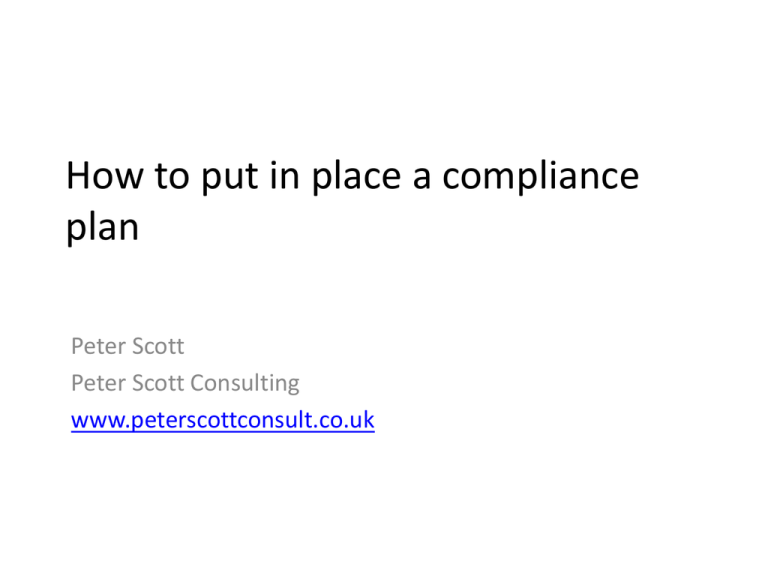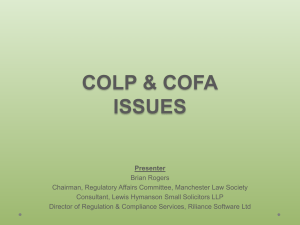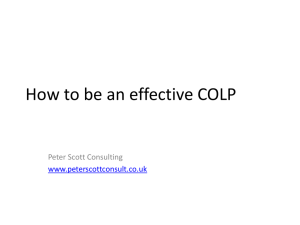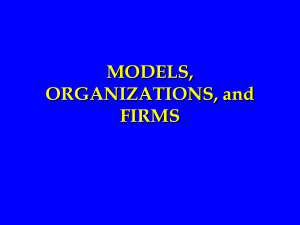How to put a compliance plan in place
advertisement

How to put in place a compliance plan Peter Scott Peter Scott Consulting www.peterscottconsult.co.uk The scope of this session • why all firms are going to need a compliance plan for the purposes of outcomes focused regulation; • compliance procedures which will need to be covered by a compliance plan; and • how a plan will need to be managed with a view to a firm not only being compliant and but also being able to demonstrate compliance. Why do you need a compliance plan? Rule 8.2 Authorisation Rules provide An authorised body (i.e. a law firm) must at all times have suitable arrangements in place to ensure that: 1. the [firm], its managers and employees, comply with the SRA's regulatory arrangements as they apply to them, as required under section 176 of the LSA and Rule 8.1 above; and 2. the [firm] and its managers and employees, who are authorised persons, maintain the professional principles. 1. The [firm], its managers and employees, comply with the SRA's regulatory arrangements as they apply to them, as required under section 176 of the LSA and Rule 8.1 above This will include all Principles, rules, outcomes and other requirements of the SRA Handbook For example, under Chapter 7 of SRA Code the Outcomes provide that firms must, inter alia .... - have appropriate systems and controls in place to achieve and comply with all Principles, rules and outcomes and other requirements of the Handbook - identify, monitor and manage risks to the achievement of all outcomes, rules, Principles and other requirements in the Handbook if applicable and take steps to address issues identified Do you already have appropriate systems and controls in place to comply? The Principles • Uphold the rule of law and proper administration of justice • Act with integrity • Do not allow your independence to be compromised • Act in the best interests of each client • Provide a proper standard of service to clients The Principles continued • Behave in a way that maintains the trust the public places in you and in the provision of legal services • Comply with your legal and regulatory obligations and deal with your regulators and ombudsmen in an open, timely and co-operative manner • Run your business and carry out your role in the business effectively and in accordance with proper governance and sound financial and risk management principles • Run or carry our your role in the business in a way that encourages equality of opportunity and respect for diversity. • Protect client money and assets The outcomes in the Code cover these areas ... • • • • • • • • • • • Client care Equality and diversity Conflict of interests Your client and the court Your client and introductions to third parties Management of your business Publicity Fee sharing and referrals You and your regulator Relations with third parties Separate businesses The Guidance Notes to Rule 8 of the Authorisation Rules say a compliance plan should include ..... • clearly defined governance arrangements providing a transparent framework for responsibilities within the firm • appropriate accounting procedures • a system for ensuring that only the appropriate people authorise payments from client account • a system for ensuring that undertakings are given only when intended, and compliance with them is monitored and enforced Rule 8 Guidance notes continued • appropriate checks on new staff or contractors • a system for ensuring that basic regulatory deadlines are not missed e.g. submission of the firm's accountant's report, arranging indemnity cover, renewal of practising certificates and registrations, renewal of all lawyers' licences to practise and provision of regulatory information • a system for monitoring, reviewing and managing risks • ensuring that issues of conduct are given appropriate weight in decisions the firm takes, whether on client matters or firm-based issues such as funding Rule 8 Guidance Notes continued .... • file reviews • appropriate systems for supporting the development and training of staff • obtaining the necessary approvals of managers, owners and COLP/COFA • arrangements to ensure that any duties to clients and others are fully met even when staff are absent. 2. The [firm] and its managers and employees, who are authorised persons, maintain the professional principles. • that authorised persons should act with independence and integrity, • that authorised persons should maintain proper standards of work, • that authorised persons should act in the best interests of their clients, • that persons who exercise before any court a right of audience, or conduct litigation in relation to proceedings in any court, by virtue of being authorised persons should comply with their duty to the court to act with independence in the interests of justice, and • that the affairs of clients should be kept confidential Where to start? • Which areas will need to be covered? • Which areas should be given priority? Begin by looking at your current procedures to see if they are: - adequate? - Need upgrading? - Adding to? Client care For example: • • • • • • • • Procedures for accepting / terminating instructions File opening Complaints handling / records Dealing with clients’ matters Fee arrangements with clients Engagement letters Costs information Financial benefits Equality and diversity For example: • • • • • • Written policies Recruitment and interview procedures Promotion and development criteria Staff training records Workplace diversity monitoring References Do your people know where to find your policies and know what they say? Conflict of interests For example: • • • • • Systems and controls to identify conflicts Governance procedures to manage issues relating to conflict Policies for different areas of work Policies on use of information barriers Register of partners’ interests Confidentiality and disclosure For example: • Systems and controls to protect client confidential information • Policies on use of information barriers • Registers of outsourcing arrangements and confidentiality agreements Introductions to third parties For example: • Policies and procedures to be followed when referring clients to third parties • Register of financial arrangements with third parties • Systems and controls to ensure clients are fully informed about financial arrangements Management and governance For example: • • • • • • • • • • Documentation as to governance and reporting lines Training and communication to all appropriate personnel in respect of policies Systems and controls relating to compliance, including monitoring, reporting and remedial action and the maintenance of financial stability regular review of procedures supervision arrangements file reviews outsourcing contractual arrangements undertakings policies management of regulatory deadlines, including practising certificates Publicity For example: • systems and controls to ensure all information in publicity and stationary is accurate and not misleading • protocols with external marketing advisers Some other areas For example: • • • • • • • • • business continuity plan business plan for each part of the firm library register procedures for risk assessments, audits and remedial procedures training records data protection file closure / file storage / archiving deeds storage anti- money laundering Some other areas continued .... • • • • • • • record of claims and notifications to insurers health and safety policies intranet policies email and internet policies Bribery Act Checks on new staff and contractors office procedures not covered by the above And of course, last but not least, governance procedures in relation to the COLP and COFA and how they will be supported in carrying out their roles. Planning how to put in place a compliance plan Your challenge It will not be sufficient just to be compliant “If you cannot demonstrate compliance we may take regulatory action” SRA - OFR at a glance 1. Buy – in from everyone in your firm will be necessary • Needs to be management driven, with top level buy-in • Zero tolerance is required • Managing compliance risk needs to be seen as ‘everyone’s job’ – a mind set change is needed • Need a ‘no blame’ culture to encourage disclosure • Above all – identify your ‘big gorillas’ and deal with them Otherwise everyone is at risk “Heavyweight gorilla” “You can’t manage me. I’m a big biller!” “That’s a great idea …for the rest of you!” Use education and training to obtain buy-in Put in place a programme of education and training for all your people so they understand that everyone without exception needs to follow procedures Otherwise everyone is at risk 2. Establish the resources you will need to put in place a compliance plan For example: • • • • • Internal or external? Part time partners or professionals? Paper records or use of IT If IT is used - bespoke or ‘off the peg’ systems? Do you have a budget? You will need a team to help you put together your compliance plan Build a team around you to deal with this - Assign responsibilities - Establish lines of accountability Together Each Achieves More Planning your resources Carry out a cost / benefit analysis to establish the most resource effective method for you to put in place and then manage your compliance plan Constructing a compliance plan DIAGNOSIS Identification and assessment MITIGATION Control, transfer and avoidance MONITORING Auditing, tracking and reporting When a risk crystallises LIMITATION Minimising the effect of crystallised risks A systematic approach is required • Put in place a formal compliance risk management process to identify and manage every area of compliance risk for the SRA Handbook and Code • Establish a comprehensive database covering all compliance risk areas • Standards such as Lexel and ISO 9000 are likely to help • Use of IT systems? Identifying and assessing your compliance risks DIAGNOSIS Identification and assessment MITIGATION Control, transfer and avoidance MONITORING Auditing, tracking and reporting When a risk crystallises LIMITATION Minimising the effect of crystallised risks Identifying and assessing your compliance risks Do you know your compliance risks? • What are your compliance risks? • Where does the knowledge of your compliance risk reside? • Can you access it? • Do you have systems to monitor, review and upgrade your knowledge? Failure to manage your knowledge will involve serious risk Compliance / Risk Management Knowledge Management Law firm risks Operational Management Compliance Risk Mapping IMPACT High High impact/ low incidence High impact/ high incidence Low impact/ low incidence Low impact/ high incidence Low Low High INCIDENCE Some key factors in identifying and assessing risks • • • • • • • • Areas of law practiced Claims record Number and location of offices Fee income / size of firm Commitment to best practice Knowledge management Are risk management procedures already in place? Supervision levels Some examples of compliance risks • • • • • • • • • • • Lack of management commitment to best practice and compliance risk management Lack of knowledge by management Lack of supervision High risk work Lack of client vetting / fraud Lack of client care / matter care Lack of resource capability Lack of knowledge / expertise / experience Precedents / multiple use of advice International work / overseas offices Mergers Assessment of compliance risks Consider the impact of, inter alia: • Disciplinary action • Bad publicity and loss of reputation • Lost clients • Complaints and claims • Increased P.I. premiums Using ‘brainstorming’ as a method of identifying and assessing compliance risks ‘Top down – bottom up’ brainstorming sessions in each group in your firm to: - to identify every compliance risk area are we achieving every Outcome under the new Code? are we compliant in every area? do we have gaps? what will be required to fully comply? to what standards should we comply? how should we prioritise our efforts? Risk Diagnosis Set criteria for assessing risks Identify detailed risks Identify high level risks Assess severity of detailed risks Assess severity of high-level risks Risk map Risk summary Mitigating compliance risks DIAGNOSIS Identification and assessment MITIGATION Control, transfer and avoidance MONITORING Auditing, tracking and reporting When a risk crystallises LIMITATION Minimising the effect of crystallised risks Compliance risk Mitigation Designed to:- • Ensure effective compliance • Avoid / reduce non compliance • Avoid / reduce incidence of risks • Transfer some risks Risk mitigation Risk map Risk summary Residual risk summary Consider impact / probability correlation Consider available mitigation techniques Contingency plan requirements Insurance requirements summary Required controls summary Monitoring compliance risks DIAGNOSIS Identification and assessment MITIGATION Control, transfer and avoidance MONITORING Auditing, tracking and reporting When a risk crystallises LIMITATION Minimising the effect of crystallised risks Compliance risk monitoring involves… • Auditing, tracking and reporting • Comparing actual outcomes to pre-set indicators • Confirming effectiveness of your risk responses • Reporting compliance and exceptions • Establishing [annual / periodical] compliance risk management reports NB – COLP and COFA reporting obligations to SRA Risk monitoring Required controls summary Contingency plan requirements Set risk indicators and methods to monitor them Insurance requirements summary Annual Risk Management Report Limitation of compliance risks DIAGNOSIS Identification and assessment MITIGATION Control, transfer and avoidance MONITORING Auditing, tracking and reporting When a risk crystallises LIMITATION Minimising the effect of crystallised risks Risk limitation involves • • • • Risk crystalisation scenarios Contingency plans Limitation procedures Post event assessment NB – COLP and COFA reporting obligations to SRA Advantages of a formal compliance and risk management process for the new SRA Code? • Structured approach focuses on key compliance risk areas • Can demonstrate how a firm is complying and the effectiveness of compliance / outcomes • Continuous monitoring ensures management of compliance and risk is “lived” day to day • Universal application to all compliance and risk areas • Comfort / assurance to PI insurers [and SRA?] Use of IT systems for compliance and risk management? Use an integrated compliance risk management system to cost effectively manage compliance risk areas by: – creating and maintaining one central, up to date compliance and risk database – providing information access to all who need it in relation to exposure to risk – embedding compliance and risk management procedures – e.g. client inception procedures – streamlining identification, assessment, mitigation and monitoring of compliance risks Some areas of particular FOCUS in relation to managing compliance risks • Top level buy-in – management must not only drive compliance but also live it • Zero tolerance – just do it! • Training and education programmes to build awareness and change mind sets • Continuous and systematic monitoring and reporting Above all, you will need to continuously challenge and stress test the effectiveness of your compliance procedures “We should always be able to do better” Any questions?










